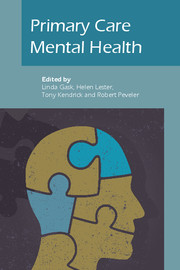Book contents
- Frontmatter
- Contents
- List of figures, tables and boxes
- List of contributors
- Preface
- Part I Conceptual basis and overarching themes
- Part II Clinical issues
- 8 Depression
- 9 Suicide and self-harm
- 10 Anxiety
- 11 Medically unexplained symptoms
- 12 Mental health problems in older people
- 13 Perinatal mental health
- 14 Child and adolescent mental health
- 15 Psychosis
- 16 Emergencies in primary care
- 17 Substance misuse
- 18 Management of alcohol problems
- 19 Eating disorders
- 20 Physical health of people with mental illness
- 21 Ethnic minorities
- 22 Asylum seekers and refugees
- 23 Sexual problems
- Part III Policy and practice
- Part IV Reflective practice
- Epilogue: Racing pigeons and rolling rocks: reflections on complex problems in primary care
- Index
8 - Depression
from Part II - Clinical issues
Published online by Cambridge University Press: 02 January 2018
- Frontmatter
- Contents
- List of figures, tables and boxes
- List of contributors
- Preface
- Part I Conceptual basis and overarching themes
- Part II Clinical issues
- 8 Depression
- 9 Suicide and self-harm
- 10 Anxiety
- 11 Medically unexplained symptoms
- 12 Mental health problems in older people
- 13 Perinatal mental health
- 14 Child and adolescent mental health
- 15 Psychosis
- 16 Emergencies in primary care
- 17 Substance misuse
- 18 Management of alcohol problems
- 19 Eating disorders
- 20 Physical health of people with mental illness
- 21 Ethnic minorities
- 22 Asylum seekers and refugees
- 23 Sexual problems
- Part III Policy and practice
- Part IV Reflective practice
- Epilogue: Racing pigeons and rolling rocks: reflections on complex problems in primary care
- Index
Summary
Defining depression
Depressive symptoms range along a continuum from everyday sadness to suicidal depression, and any cut-off between a ‘normal’ and a ‘depressed’ person is to an extent arbitrary, but categorical diagnoses are necessary in clinical practice to make decisions about intervening. Psychiatric classification systems identify a category of ‘major depression’ which predicts the need for active treatment, irrespective of environmental factors, except for bereavement (American Psychiatric Association, 2000).
Around three times as many depressed patients have symptom levels below the cut-off for major depression, which, though relatively mild, are still associated with significant distress and impairment of social functioning (Rapaport et al, 2002). Depression very commonly occurs with anxiety (see Chapter 10).
Epidemiology
The multi-country survey of 2000–2001 undertaken by the World Health Organization (WHO) found that major depression affected around 5% of women and 3% of men per year. Depression was the fourth leading cause of disease burden among all diseases, responsible for, on average, 4.4% of total disability-adjusted life-years lost (ranging from 1.2% in Africa to 8.0% in the Americas), which had increased from 3.7% in 1990. Depression caused the largest amount of non-fatal burden among all diseases: 12.1% of total years lived with disability on average, which had increased from 10.7% in 1990 (Üstün et al, 2004).
Cross-sectional surveys have shown an increasing prevalence of depression, prompting talk of an epidemic of depression. The prevalence of major depression doubled among US adults between 1992 and 2002 (Compton et al, 2006). Depression is now the second (for women) or third (for men) biggest cause of long-term sickness benefits in the UK (Moncrieff & Pomerleau, 2000) and all high-income countries have seen year-on-year increases in antidepressant prescribing in primary care since the selective serotonin reuptake inhibitors (SSRIs) were introduced in 1990 (Middleton et al, 2001). Depression is predicted to be second after ischaemic heart disease in global health burden by 2020 (Murray & Lopez, 1997).
- Type
- Chapter
- Information
- Primary Care Mental Health , pp. 107 - 124Publisher: Royal College of PsychiatristsPrint publication year: 2009



